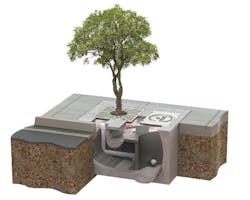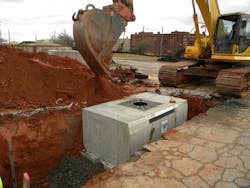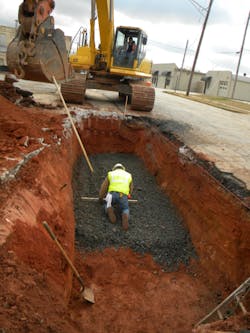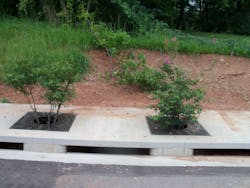BioPod™ Box Filters Help Reclaim a Lost Neighborhood College Park, Georgia
BioPod™ Box Filters Help Reclaim a Lost Neighborhood College Park, Georgia
Project Overview
Plant a tree, grow a business park. Two of the significant environmental challenges facing new construction projects are water conservation, and the handling of stormwater runoff to remove pollutants. In a recent project in College Park, Georgia, the two are solved together in an elegantly linked plan. It is the first use in the southeastern U.S. of the BioPod™ box biofilter, a new product for stormwater collection and primary treatment.
College Park, a small city on the southern border of the metropolis of Atlanta, wanted to redevelop an abandoned residential neighborhood into a viable commercial district. The neighborhood comprises a 16-block corridor west of Hartsfield-Jackson Atlanta International Airport, the busiest airport in the world. When the airport was expanded in the 1980’s, the neighborhood came directly under the new flight path. The homes were bought up by the airport through a Federal Aviation Administration (FAA) noise abatement program, and all but a few were leveled. The largely uninhabited area became blighted, attracting an undesirable element of people and activities.
However, the location has great potential. It is adjacent to both airport and interstate highways on the east. On the south, it borders the Georgia International Convention Center, two hotels and an office park. On the west is a golf course. Moreover, it is 15 minutes by rail to downtown Atlanta. Wanting to turn the area around, College Park gradually bought the parcels back from the City of Atlanta, hoping to redevelop it as a commercial district.
Missing Infrastructure
One of the first steps towards making the area attractive to businesses was to provide missing infrastructure. The neighborhood was very old. It had gas, water and sanitary sewer services, but no stormwater drainage system. “Every time it rained,” explains Jackson Myers, City Engineer for the City of College Park, “the streets flooded. It was unsafe to drive because of hydroplaning.” Moreover, the road surfaces were, not surprisingly, in terrible condition.
In early 2009, when the incoming Obama administration was seeking public projects to stimulate the economy, College Park proposed a Low-Impact Development (LID) green solution to improve the area with a sustainable stormwater and irrigation system.
The proposal was actually two closely related projects, both of which enabled the city to make better use of stormwater runoff. The concept for the first phase, the neighborhood redevelopment, was to collect runoff from the streets of the 16-block corridor and pipe it to two large new sedimentation ponds comprising the Camp Creek Drainage Basin. Simultaneously, they would install a new irrigation water supply system to the corridor, which would draw water from the sedimentation ponds. This would reduce the city’s current expenses for bringing water in from another county.
Building regional stormwater infrastructure creates an incentive for businesses to build in College Park. An incoming company can save the $250,000 - $350,000 expense of building an individual detention system. Instead, they could tie into the regional system for approximately $10,000 per acre, minimizing their upfront building costs and saving precious property for more profitable uses. In addition, they can tie into a low-cost source for irrigation water.
The stormwater system had to be designed to handle the entire future build-out of the neighborhood, not just the existing streets. The city assumed that the area - approximately 100 acres - would eventually be 10% green space, with the rest either hardscape or rooftop surfaces.
The second phase involved the adjacent Gordon Morris Memorial Golf Course, a nine-hole course built in the 1930’s where stormwater runoff drains to the golf course pond. The city proposed piping from the pond to irrigate not only the golf course but also the grounds of the adjacent 26-acre Georgia International Convention Center, again saving money and natural resources. Engineering for both phases was done by Prime Engineering in Atlanta, Georgia.
The project was approved at a budget of $5 million, making it the largest stormwater management project of its type in the southeast. Of this, $2.6 million was for installation of the neighborhood stormwater system, $1.5 million for the golf course system, and $880,000 for engineering services. With funding from the American Recovery and Reinvestment Act (ARRA) of 2009 and the Georgia Environmental Finance Authority (GEFA), $3 million of that total does not have to be repaid, giving the city a big boost to reclaim this area as useful, revenue-producing land.
Biofiltration
For the heart of the stormwater management system, the city selected BioPod biofilters manufactured by Oldcastle Stormwater. BioPod biofilters are open-bottomed box filters that remove suspended solids, petrochemicals and other pollutants using natural filtration methods. This treatment method enables the project to meet the 80% TSS (Total Suspended Solids) removal requirement in the Georgia Stormwater Management Manual in a low-impact manner. Over 100 BioPod units were installed, making this one of the largest projects of its kind.
Water is collected at the curb cut or inlet. The biofilter portion of the system includes a 4-inch top filter layer of shredded mulch and an 18-inch layer of non-proprietary filter media, (a high-capacity planting mix), yielding a maximum design treatment loading rate of 1.0 gpm/sf. This provides a treated flow capacity of 32 gpm (0.071 cfs) for a 4-foot x 8-foot unit. Beneath the filtration media is a separation layer and a 6-inch perforated pipe to collect treated runoff, carry it out of the BioPod unit, and then into the regional drainage system. The pipe is bedded in angular drain rock that fills the bottom of the box and forms the transition to the soil beneath the unit.
Pollutant removal efficiencies for such biofilter cells (high rate vegetated media filters) or tree box filters with these characteristics exceed most of EPA’s other structural best management practices (BMPs). Some pollutants are broken down and become nutrients for the trees.
During a storm, the “first flush” of pollutant-heavy runoff - including oil and grease, bacteria, heavy metals, other suspended solids and large debris - enters the unit. As water moves through the system, suspended solids and pollutants are removed by settling and filtration. Large debris is collected on top of the mulch layer, under the grate, and can be easily removed by maintenance crews. In fact, maintenance consists largely of debris removal, and periodic replacement of the top mulch layer.
The green nature of this solution was an important element in obtaining funding. “Without the BioPods,” explains City Engineer Jackson Myers, “the project never would have been approved.”
The College Park project used a simplified BioPod model. Typical units include a pre-filter chamber and a bypass feature. The pre-filter collects large debris and keeps it out of sight until maintenance crews can remove it. The bypass is designed to handle high flows, eliminating the need for installing a separate high-flow bypass structure. Filtered water is collected by a geotextile-wrapped 6-inch perforated pipe, and then carried out of the unit to the sedimentation ponds.
“BioPods are supplied as a ‘turn-key’ solution,” explains Skip Short, Oldcastle vice president. “We provide the BioPod unit, soil media, grates and tree. We also plant the tree, and maintain it at no cost for the first year.” The company helped College Park choose regionally appropriate trees – Crape Myrtles, Apple Serviceberries and Flowering Dogwoods – which are warranted for one year.”
The city is now advertising the area’s availability for development, and they have received interested responses including some from overseas. Myers is enthusiastic about the use of biofilters for stormwater quality. “We’re the first project with this type of system here in the southeast. But I’m excited, and hoping we’re starting a trend.”



